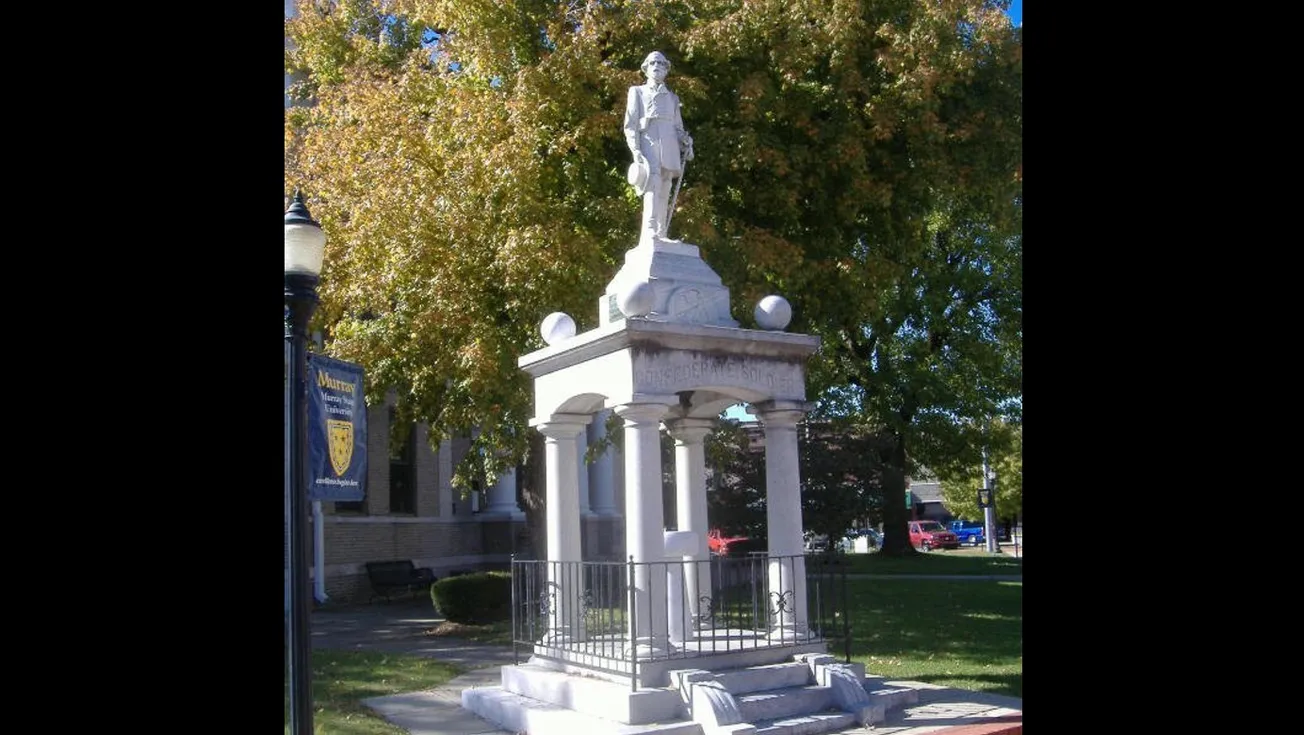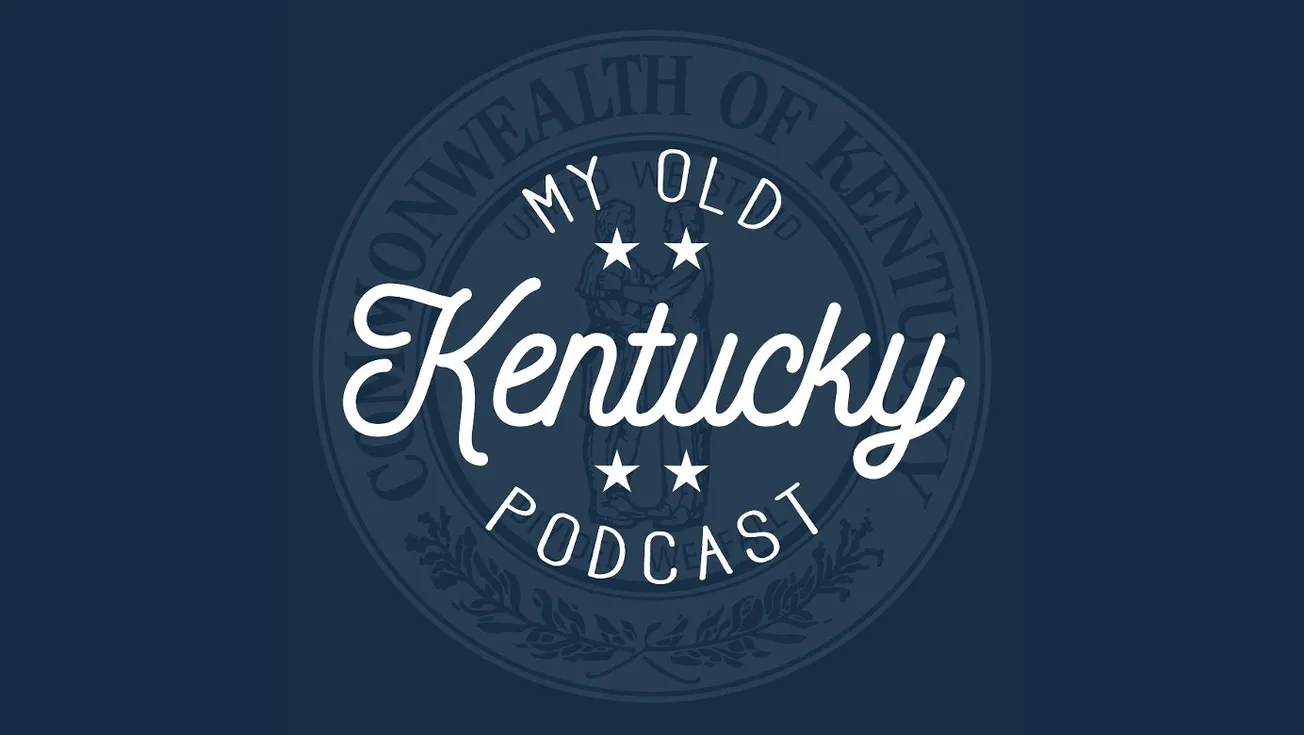Murray’s controversial court square Confederate monument “represents a distorted, bloody, and awful past that we cannot forget but should not celebrate,” said Murray State University historian Brian Clardy.
The 1917-vintage stone memorial topped by a 5½-foot statue of Robert E. Lee, the Confederacy’s most famous general, is the subject of a new film, “Ghosts of a Lost Cause” by Sherman Neal II and Gerry Seavo James, which will be shown at Murray State University’s Wrather Hall at 6 p.m. on Jan. 15. The film will be followed by a panel discussion. Click here to purchase tickets.
About 800 Calloway County men joined the Confederate army, though apparently few, if any, of them soldiered under Lee.
Paid for by a United Daughters of the Confederacy fund-drive, the monument, which included a whites-only drinking fountain during segregation days, was typical of hundreds of such Confederate memorials — many, if not most, of them UDC-sponsored. Typically made of stone or bronze, or both, nearly all of the tributes were erected in the late 19th and early 20th centuries on courthouse lawns and in parks, cemeteries, and other public places.
The real Robert E. Lee
Dozens of memorials have been removed in recent years, including a large bronze equestrian statue of Lee in Richmond, Virginia, the Confederate capital for most of the Civil War. Defenders of the statuary and Lee, whom many white Southerners revere, took to social media and “revived old claims that Lee was against secession and slavery, was practically an abolitionist, and never personally owned enslaved people,” wrote The Washington Post's Gillian Brockell.
She added, “On the one hand, it is true that Lee opposed secession in early 1861, before Virginia seceded. On the other hand, there’s everything else.
“For example, Lee also said he would ‘never bear arms against the Union’ except to defend Virginia — a vow he did not keep at Antietam or Gettysburg. And despite what old revisionist history or social media memes claim, Lee owned enslaved people. He drove them hard, and he pursued and punished them when they escaped. He separated families to pay off debts and fought in court to prevent them from being freed.”
Other Kentucky monuments are gone
Officials in Louisville and Lexington also removed local Confederate monuments. Others have come down across the old Confederate states. Calloway County and the rest of the Jackson Purchase were overwhelmingly pro-Confederate. The rest of Kentucky, while divided, was mainly pro-Union. The state spurned secession, and many more Kentuckians donned Union blue than opted for Confederate gray.
The Southern Poverty Law Center cites New Orleans, a key Confederate port, where “in 2017, then-Mayor Mitch Landrieu powerfully defended the city’s removal of three prominent monuments and denounced the ‘false narrative’ promoted by the ‘Cult of the Lost Cause.’
“’That cult,’ he said, ‘had one goal — through monuments and through other means — to rewrite history to hide the truth, which is that the Confederacy was on the wrong side of humanity.’”
The SPLC encourages “communities across the country to reflect on the true meaning of these symbols and ask the question: Whose heritage do they truly represent?”
After a white police officer murdered George Floyd, who was Black, in 2020, protests against racism and police brutality erupted nationwide. Some of the protests included demands that Confederate statues and monuments like the one in Murray be taken down.
Neal, then a Murray State football coach, sent a letter to Murray Mayor Bob Rogers asking that the moment be removed because it was “an affront to all residents who support notions of equality and value the American justice system.” Neal added, “The ‘friendliest small town in America’ must remove this symbol of oppression if the purported friendliness extends to its black residents.”
Lee’s last stand?
The Murray City Council unanimously resolved to ask the Calloway County Fiscal Court to “expeditiously remove and relocate” the monument. But the monument still stands because the courthouse and court square are county, not city, property. The all-white county fiscal court has been disinclined to remove the monument.
Besides Neal, the resolution was backed by both Murray State University and former Murray State basketball standout Ja Morant, who is now a star for the Memphis Grizzlies of the National Basketball Association.
Gov. Andy Beshear called for the removal of all Confederate memorials in public spaces in Kentucky, notably a marble statue of Confederate President Jefferson Davis, a Kentucky native, in the Capitol rotunda in Frankfort.
“If it is at a courthouse, it ought to come down,” he said. “Having a Confederate monument on courthouse grounds or in the rotunda is not the right thing.”
In her inaugural address on the Capitol steps earlier this month, Lt. Gov. Jacqueline Coleman referred to the Davis monument: "The symbolism on these grounds is important, and so are the lessons we draw from it. But it is just as important what you don’t see here today. There is an empty space in the rotunda where the statue of Jefferson Davis once stood. That is because we not only installed the capitol’s first female statue, we also removed one that represented division. Of course, removing a statue doesn’t change history. But we can all agree that every Kentuckian – young and old, male and female, all colors, and all faiths — deserve to feel that they belong, if this is truly to be the ‘People’s House.’”
The state removed the Davis statue in 2020, the same year that Daviess County’s all-white fiscal court voted to take down the statue of a Confederate soldier on the courthouse lawn in Owensboro. A lawsuit over the monument’s ownership delayed the removal until 2022.
Did old-time Republicans call Confederates traitors?
During the Civil War, Republicans, then a Northern anti-slavery party, denounced Davis and the Confederates as traitors. But many current Republicans, including Donald Trump, have defended the Confederate monuments – and opposed efforts to rename military bases named for Confederate generals.
“Confederate heroes and the battle flag they fought under were willing, as John C. Calhoun wrote, ‘to drench the country in blood’ to maintain white supremacy,” wrote Jeffery Robinson of the American Civil Liberties Union. “Preserving their names on military institutions essentially tells Black Americans, ‘We don’t care what they did to your ancestors. Don’t bring it up, or we will be even more divided.’ Monuments that portray confederate traitors as heroes have done nothing to prevent a new rise in white supremacy — they are literally monuments to this harmful, racist ideology, which will be engrained in our memories and history books no matter how many monuments are toppled.”
Meanwhile, in 2020, as protestors gathered to demand the Murray monument’s removal, counter-protestors rallied to defend it. Murray became part of the nationwide dispute over Confederate monuments and the Confederate flag.
Monument supporters claim that removing them erases history. They say the monuments — and the flag — don't glorify slavery. Rather, they maintain, the iconography represents “heritage, not hate” and honors the memory of ordinary Confederate soldiers.
The SPLC and many scholars weigh in on the claims defending the statues
The SPLC says the “heritage, not hate” claim “ignores the near-universal heritage of African Americans whose ancestors were enslaved by the millions in the South. It trivializes their pain, their history, and their concerns about racism — whether it’s the racism of the past or that of today. And it conceals the true history of the Confederate States of America and the seven decades of Jim Crow segregation and oppression that followed the Reconstruction era.”
Clardy, who will be part of the panel discussion after the film is shown, said the Murray monument “sends a signal to people of color and others that you’re not welcome here.” Many scholars agree with him.
“The Confederates lost the war, the rebellion,” said Harvard University historian Annette Gordon-Reed. The victors, the thousands of soldiers — black and white — in the armed forces of the United States died to protect this country. I think it dishonors them to celebrate the men who killed them and tried to kill off the American nation.”
She disagrees that removing the monuments is erasing history. “History will still be taught. We will know who Robert E. Lee was. Who Jefferson Davis was. Who Frederick Douglass was. Who Abraham Lincoln was. There are far more dangerous threats to history. Defunding the humanities, cutting history classes and departments. Those are the real threats to history.”
The “slippery slope?”
Gordon-Reed doesn't buy the “slippery slope” argument that getting rid of Confederate monuments will necessarily lead to the razing of memorials to slave-owning “founding fathers” like George Washington and Thomas Jefferson: “There is an important difference between helping to create the United States and trying to destroy it. Both Washington and Jefferson were critical to the formation of the country and to the shaping of it in its early years. They are both excellent candidates for ... contextualization. ...
“The Confederate statues were put up ... to send a message about white supremacy, and to sentimentalize people who had actively fought to preserve the system of slavery. No one puts a monument up to Washington or Jefferson to promote slavery. The monuments go up because, without Washington, there likely would not have been an American nation. They put up monuments to T.J. because of the Declaration of Independence, which every group has used to make their place in American society. Or they go up because of T.J.’s views on separation of church and state and other values that we hold dear. I think on these two, Washington and Jefferson, in particular, you take the bitter with sweet. The main duty is not to hide the bitter parts.”
Western Carolina University anthropologist Ben Steere argues that the monuments weren’t really built to honor the Confederate soldiers because they were erected long after the war ended. Their purpose, he said, was “to push back against the racial progress of Reconstruction.”
Added Steere, a Tarheel State native: “I support the removal of Confederate monuments in my home state of North Carolina. I support their removal everywhere. Doing so will not erase history. Instead, it will add another layer to the archaeological record of our nation’s long, tortured attempt to wrestle with its original sins of genocide, land theft, and slavery.”
Likewise, the Society of Architectural Historians says Confederate memorials “express white supremacy and dominance, causing discomfort and distress to African American citizens who utilize the public spaces occupied by these monuments. Our inaction gives these monuments power. By leaving them in place, we allow the dead hand of the past to direct some Americans away from that which belongs to all of us. History has proven that progress is possible, but also that the persistent racial schism in our society will not be conquered without radical, sustained action. The removal of Confederate monuments is a necessary and important step in this process, and one that cannot wait any longer.”
Clardy said that Confederate monuments are the most visible symbol of the Lost Cause myth, which holds that slaves were universally happy in bondage and that slavery had little or nothing to do with the Civil War. Myth-makers and preservers, he added, also claim the Confederacy was based on “states’ rights” and that the North forced the South to fight to defend those “rights.”
Clardy said that by “states’ rights” the Confederates meant the right of states to sanction slavery. (White Southerners also cried “states’ rights” in defense of Jim Crow segregation and Black disenfranchisement.)
Retired Morehead State University historian John Hennen said that after Reconstruction – when the Jim Crow era started – “there was a conscious effort by white Southerners to deny that the Civil War had anything to do with slavery. Oh, no, they said they fought in defense of local sovereignty.” He said “states’ rights” in the antebellum South meant preserving slavery and white supremacy. (In the 1960s, Congress passed landmark civil rights legislation aimed at ending Jim Crow racism.)
In his 2001 book, Apostles of Disunion: Southern Secession Commissioners and the Causes of the Civil War, historian Charles B. Dew wrote that after the Confederates lost the Civil War, many of their civilian and military leaders wrote memoirs, in which they maintained "that slavery had absolutely nothing to do with the South’s drive for independence.” He added that their whitewash is being applied by “neo-Confederate writers and partisans of the present day.”
In his book, Dew quoted the Confederates themselves on what prompted secession and the creation of the Confederacy.
Jefferson Davis praised slavery as a worthy institution by which “a superior race” had transformed “brutal savages into docile, intelligent and civilized agricultural laborers.”
Vice President Alexander H. Stephens was thankful the Confederacy was based “upon the great truth that the negro is not equal to the white man; that slavery, subordination to the superior race, is his natural and moral condition.” He added that the Confederate States of America was, therefore, “the first Government ever instituted upon principles in strict conformity to nature and the ordination of Providence…”
Dew also quotes from secession ordinances Southern states wrote as they exited the Union. When Texans pulled out, they denounced “the debasing doctrine of the equality of all men, irrespective of race and color — a doctrine at war with nature, in opposition to the experience of mankind, and in violation of the plainest revelations of Divine Law.”
Mississippi secessionists announced that “Our position is thoroughly identified with the institution of slavery….We must either submit to degradation and to the loss of property worth four billions of money, or we must secede from the Union.”
Dew focused his book on a group of state-appointed commissioners who made the rounds of the slave states in 1860 and early 1861. They preached the same racist line: the only way to keep Lincoln and the Yankee “Black Republicans” from destroying slavery and white supremacy was to start a new Southern nation.
“Our fathers made this a government for the white man, rejecting the negro, as an ignorant, inferior, barbarian race, incapable of self-government, and not, therefore, entitled to be associated with the white man upon terms of civil, political, or social equality,” a Mississippi commissioner said.
Declared another Magnolia State representative: “Slavery was ordained by God and sanctioned by humanity.”
Likewise, a Kentucky-born Alabama commissioner to the Bluegrass State pleaded that secession was the only way the South could sustain “the heaven-ordained superiority of the white over the black race.” Another Alabama ambassador said ideas that slavery was immoral and that God created all people the same were rooted in “an infidel theory [that] has corrupted the Northern heart.”
Dew concluded, “By illuminating so clearly the racial content of the secession persuasion, the commissioners would seem to have laid to rest, once and for all, any notion that slavery had nothing to do with the coming of the Civil War.”
Kentucky’s Confederate press: slavery and white supremacy were on the line
Kentucky's pro-Confederate newspapers stuck to a theme common to the Confederate press throughout the South: only secession could save slavery and white supremacy.
Typical of the Confederate papers was the Louisville Daily Courier, the state’s most important secessionist organ. For example, the Courier pandered directly to less well-heeled Kentuckians who did not have slaves: “Have the non-slave holders of Kentucky ever thought of the ... effect of the emancipation of all the slaves in the country? Do they wish to send their children to schools in which the negro children of the vicinity are taught?”
The questions continued, rapid-fire: “Do they wish to give the negro the right to appear in the witness box to testify against them? Do they wish to see the negro privileged to serve on juries sitting on their property, liberty, or life? Do they wish to be met at the polls, and have their votes neutralized, by the suffrage of the free negroes? Do they wish to have the emancipated slaves brought into competition with them in the field, in the workshop, in all the pursuits of life?”
The smaller Confederate papers pushed the same racist line. The weekly Princeton Bulletin challenged its readers to “reflect on how you would like [emancipated slaves] ... to become as they would by this step, the every day companions and associates of your wives and children; your peers at the ballot box, and your legislators in public assemblies.”
The weekly Cadiz Organ demanded to know if white Kentuckians would at Lincoln’s “command ... bow their heads and receive again the yoke of free negro Black Republican despotism and inequality”? Or would they “stand as idlers and behold an army of Abolition minions, with hearts festering with treason as black as hell itself, attempt to force our friends, our neighbors, our brothers of the South, into ignominious SUBMISSION TO NORTHERN RULE AND TYRANNY?”
The Confederate constitution and slavery
Meeting in Montgomery, Alabama, the first Confederate capital, in February, 1861, representatives of the original seven Confederate states drew up a constitution that explicitly safeguarded slavery.
They modeled their charter after the U.S. constitution but “purged the original of euphemisms, using the term slaves instead of other persons in its three-fifths and fugitive-slave clauses. It bound the Congress and territorial governments to recognize and protect ‘the institution of negro slavery,’” Columbia University historian Stephanie McCurry wrote in The Atlantic.
“But the centerpiece of the Confederate constitution — the words that upend any attempt to cast it simply as a copy of the original — was a wholly new clause that prohibited the government from ever changing the law of slavery: ‘No … law denying or impairing the right of property in negro slaves shall be passed.’ It also moved to limit democracy by explicitly confining the right to vote to white men. Confederates wrote themselves a pro-slavery constitution for a pro-slavery state.”
(Some Confederate apologists like to point out that the constitution’s framers outlawed the transatlantic slave trade. But their motives were political, not humanitarian. The Confederates were desperate for British recognition and support. Resurrecting the slave trade, which the U.S. constitution banned after 1808, would have risked a confrontation with Britain’s powerful navy, the ban’s chief enforcer.)
Clardy said that for years after the war, “Lost Cause” proponents deliberately ignored historical evidence and depicted the defeated Confederates as helpless victims of vengeful, victorious Yankees.
But the ex-Confederates got off astonishingly easy compared to losers in other armed rebellions in other countries. There were no mass executions, no mass imprisonments, and no mass confiscation of land and property. Most former rebels ultimately got their citizenship back; after Reconstruction, the pre-war planter aristocracy — including many who had been leaders in the Confederate military and government — returned to dominance in Southern politics and society. They called themselves “Redeemers.”
The Ku Klux Klan, the Redeemers’ terrorist arm, used violence to help subvert biracial, freely-elected Republican-led Reconstruction governments, to intimidate the newly-freed slaves and Republicans, and to reinstate white supremacy and oppression of Blacks as close to slavery as possible under the 13th Amendment to the Constitution which outlawed slavery.
Armed, hooded, and robed Klansmen and members of similar secret groups lynched, tortured, and burned out Blacks, while local law officers looked the other way. More than a few lawmen were Klansmen. Nonetheless, the United Daughters of the Confederacy spread the Lost Cause lie, insisting that Klansmen and their ilk were heroes and gallant defenders of white Southern homes and hearths — and especially white Southern womanhood.
In a Facing South article, Greg Huffman wrote that in 1926, the UDC even erected a monument to the Klan. Its inscription read in part: “IN COMMEMORATION OF THE ‘KU KLUX KLAN’ DURING THE RECONSTRUCTION PERIOD FOLLOWING THE ‘WAR BETWEEN THE STATES’ THIS MARKER IS PLACED ON THEIR ASSEMBLY GROUND.”
“Let’s just call Confederate soldiers what they were – traitors,” said Clardy. “They were disloyal to the United States. They shed American blood, and they do not need to be lionized for that.”
--30--
This is a version of a story that appeared in the Murray Sentinel, an online publication.







